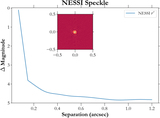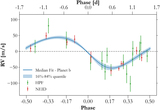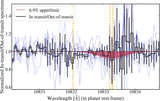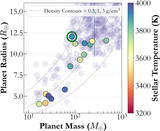Image Details

Caption: Figure 12.
We create a simulated JWST/NIRSpec-Prism transmission spectrum of TOI-3757 b (assuming a single transit) using uncertainties calculated with PandExo (Batalha et al. 2017) assuming an aerosol-free 10×solar-metallicity atmosphere model (blue) generated using Exo-Transmit (Kempton et al. 2017). We also plot the same underlying composition model plus an opaque aerosol layer at 1 mbars (green) and 0.1 mbars (orange) for comparison. We assume these aerosols to be gray absorbers (i.e., no wavelength-dependent absorption features). Based on PandExo simulations, we find that even with a high-altitude aerosol layer of 0.1 mbars, we should still detect water, methane, and carbon dioxide present in TOI-3757 b’s atmosphere with JWST at ∼ 9σ compared to a featureless flat spectrum.
Copyright and Terms & Conditions
© 2022. The Author(s). Published by the American Astronomical Society.












